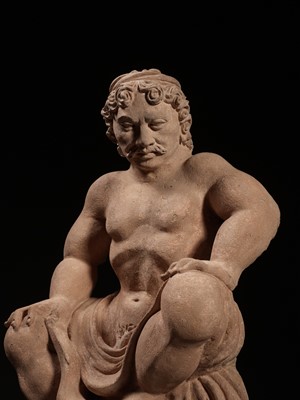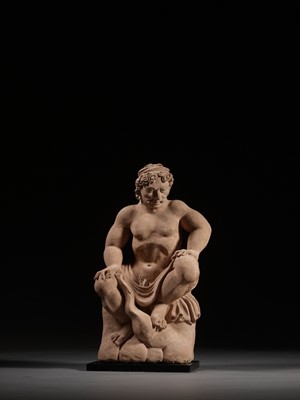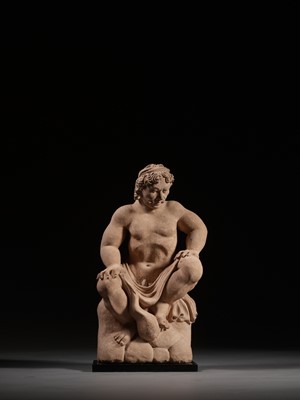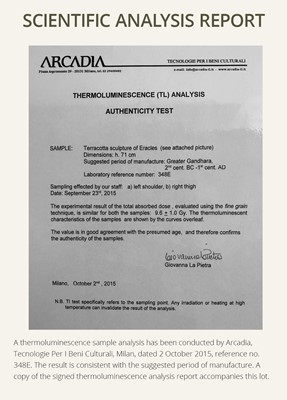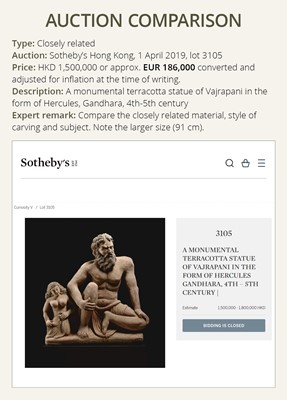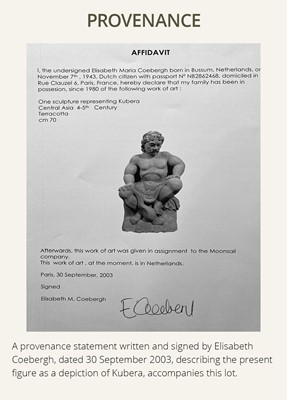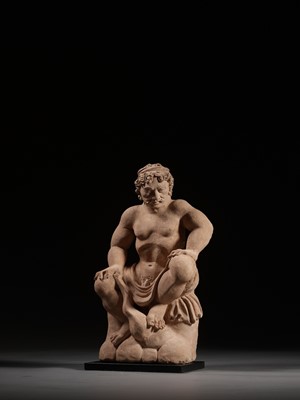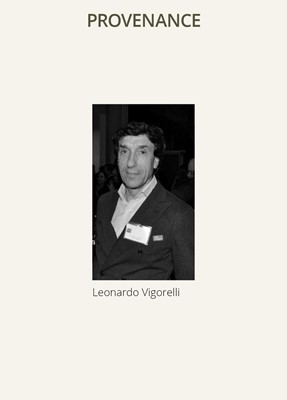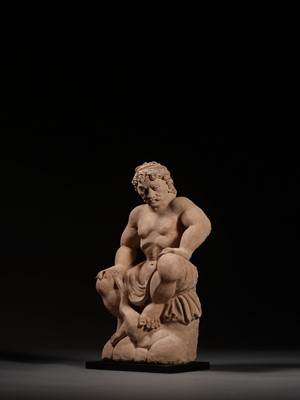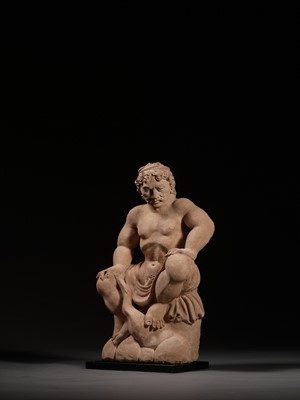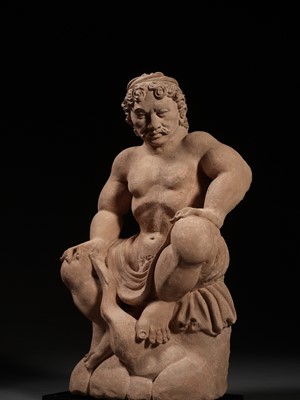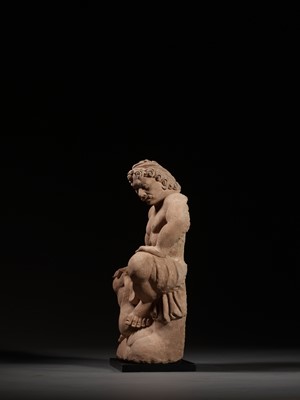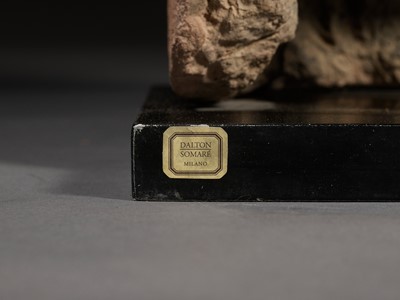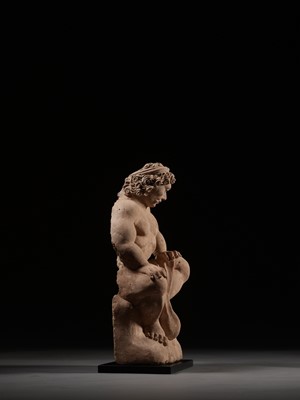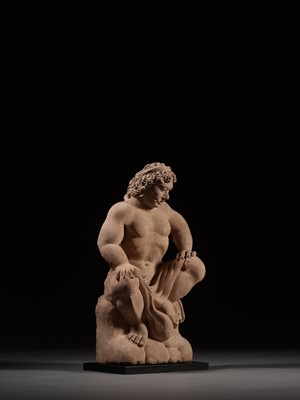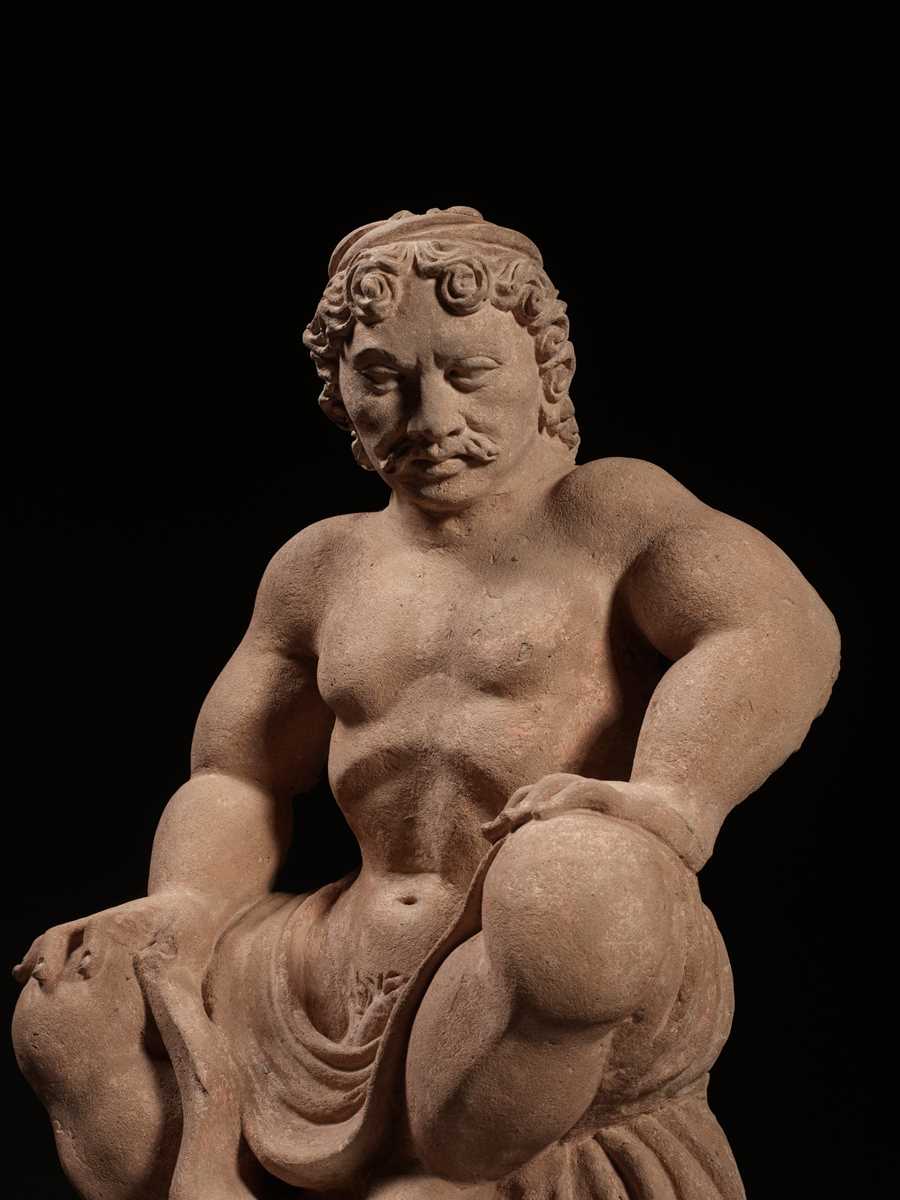9th Mar, 2023 13:00
TWO-DAY AUCTION - Fine Chinese Art / 中國藝術集珍 / Buddhism & Hinduism
230
AN IMPORTANT TERRACOTTA STATUE OF VAJRAPANI IN THE FORM OF HERCULES, ANCIENT REGION OF GANDHARA
犍陀羅重要金剛手菩薩神頭像呈赫拉克勒斯陶像
Sold for €41,600
including Buyer's Premium
Scientific Analysis Report: A thermoluminescence sample analysis has been conducted by Arcadia, Tecnologie Per I Beni Culturali, Milan, dated 2 October 2015, reference no. 348E. The result is consistent with the suggested period of manufacture. A copy of the signed thermoluminescence analysis report accompanies this lot.
4th-5th century. The gallant masculine figure seated with his hands placed on his knees, his torso left bare save for a loin cloth gathered around the waist, the mustachioed face with almond-shaped eyes and full lips, the curled hair secured by a twisted headband.
Provenance: Collection of Elisabeth Maria Coebergh, Paris, France, acquired c. 1980. An important private collection of a distinguished gentleman in Milan, Italy, assembled in the 1990s and early 2000s, acquired from the above in 2003. Collection of Leonardo Vigorelli, Bergamo, acquired from the above. A provenance statement written and signed by Elisabeth Coebergh, dated 30 September 2003, describing the present figure as a depiction of Kubera, accompanies this lot. Leonardo Vigorelli is a retired Italian art dealer and noted collector, specializing in African and ancient Hindu-Buddhist art. After studying anthropology and decades of travel as well as extensive field research in India, the Himalayan region, Southeast Asia, and Africa, he founded the Dalton Somaré art gallery in Milan, Italy, which today is being run by his two sons.
Condition: Good condition, commensurate with age. Wear, losses, nicks, structural cracks with associated old fills, drilled holes from sample-taking, signs of weathering and erosion, encrustations.
Dimensions: Height 72 cm (incl. stand) and 74 cm (excl. stand)
Mounted on an associated stand. (2)
This large terracotta sculpture is a rare legacy of the ancient kingdom of Gandhara, encapsulating the rich cultural interplay and hybrid art styles derived from Hellenistic and Indian influences. It depicts the bodhisattva Vajrapani, the protector of Buddhism, represented with the iconography of the Greek god Hercules, who was widely venerated as a hero and savior in western Asia during the early centuries of the present era. As a great champion, yet one who nevertheless understood the human condition, Hercules was easily assimilated into Mahayana Buddhism. Like other Gandharan bodhisattvas, he is depicted as an earthly prince with his aristocratic bearing and posture. While his distinct mustache belongs to the Indian world, the naturalistic face and especially the muscular body are clearly reminiscent of Greco-Roman sculpture.
The kingdom of Gandhara lasted from 530 BC to 1021 AD, when its last king was murdered by his own troops. It stretched across parts of present-day Afghanistan and Pakistan. Gandhara is noted for its distinctive style in Buddhist art, which developed out of a merger of Greek, Syrian, Persian and Indian artistic influences. Gandharan style flourished and achieved its peak during the Kushan period, from the 1st to the 5th century. In the 1st century AD, Gandhara was the birthplace of some of the earliest Buddhist images.
The use of hard-fired earthenware instead of stone such as schist, marble or sandstone became popular during the later Gandharan period from the 4th to 6th centuries AD. Fired clay was expensive in the area, because the wood needed for the firing process was scarce. Therefore, such a large and expensive sculpture would have been a highly meritorious Buddhist offering. Only a few terracotta statues from this period and of this spectacular size have ever been recorded.
Auction result comparison:
Type: Closely related
Auction: Sotheby’s Hong Kong, 1 April 2019, lot 3105
Estimate: HKD 1,500,000 or approx. EUR 186,000 converted and adjusted for inflation at the time of writing.
Description: A monumental terracotta statue of Vajrapani in the form of Hercules, Gandhara, 4th-5th century
Expert remark: Compare the closely related material, style of carving and subject. Note the larger size (91 cm).
犍陀羅重要金剛手菩薩神頭像呈赫拉克勒斯陶像
四至五世紀。男性人物坐像,高大,比例勻稱,骨架分明,肌肉健碩。面部表情沉靜肅穆,捲髮,小鬍子。身軀裸露,腰間圍著的腰布。
科學檢測報告:隨附一份米蘭Arcadia Tecnologie Per I Beni Culturali 研究所2015年10月2日出具的熱釋光檢測報告複印本,編號 348E,其斷代結果與本文判斷一致。
來源:法國巴黎 Elisabeth Maria Coebergh收藏,約於1980年購入;一位義大利米蘭傑出的紳士收藏,建立於上世紀九十年代至2000年,於2003年購於上述收藏;義大利貝加莫Leonardo Vigorelli收藏,購於上述收藏。隨附一份2003年9月30日由Elisabeth Coebergh簽名的檔複印本,描述該像為俱毘羅。Leonardo Vigorelli是一位退休的義大利藝術品經銷商和著名收藏家,專門研究非洲和古代印度教佛教藝術。在學習人類學和數十年的旅行以及在印度、喜馬拉雅地區、東南亞和非洲的廣泛實地研究之後,他在義大利米蘭創立了 Dalton Somaré 藝術畫廊,如今由他的兩個兒子經營。
品相:品相良好,磨損、缺損、缺口、結構裂縫和相關小修、取樣鑽孔、風化和侵蝕跡象、結殼。
尺寸:高 72 厘米 (含底座)和74 厘米 (不含底座)
配置底座。(2)
這個巨大的頭像是古代犍陀羅王國文化極為罕見的遺產,包含了源自希臘和印度影響的文化互動和藝術風格。金剛手菩薩以希臘大力神赫拉克勒斯的形像出現。赫拉克勒斯在西亞廣受尊崇,是一位英雄和救世主,很容易就融入大乘佛教。與其他犍陀羅菩薩一樣,他被塑造成一個具有貴族形象的王子,但其獨特的容貌與希臘羅馬雕塑十分接近。
犍陀羅王國從西元前 530 年直到西元 1021 年,當時它的最後一位國王被自己的軍隊殺害。犍陀羅王國橫跨今天的阿富汗和巴基斯坦的部分地區。犍陀羅以其獨特的佛教藝術風格聞名,這種風格融合了希臘、敘利亞、波斯和印度的藝術影響。犍陀羅風格在 1 世紀至 5 世紀的貴霜時期蓬勃發展並達到頂峰。西元一世紀,犍陀羅是最早的佛教造像的發源地。
四世紀至六世紀後期的犍陀羅,普遍使用燒製陶土造像代替片岩雕刻。那時,燒製造像很是昂貴,因為燒製需要的木材極其稀缺。所以,如此稀有的佛像,是極有功德的供品。只有極少數來自該時期並且有這樣尺寸的造像保存下來。
拍賣結果比較:
形制:非常相近
拍賣:香港蘇富比,2019年4月1日,lot 3105
估價:HKD 1,500,000(相當於今日EUR 186,000)
描述:四至五世紀犍陀羅赫拉克勒斯陶俑
專家評論:比較非常相近的材料、雕刻風格和主題。請注意尺寸較大(91 厘米)。
Scientific Analysis Report: A thermoluminescence sample analysis has been conducted by Arcadia, Tecnologie Per I Beni Culturali, Milan, dated 2 October 2015, reference no. 348E. The result is consistent with the suggested period of manufacture. A copy of the signed thermoluminescence analysis report accompanies this lot.
4th-5th century. The gallant masculine figure seated with his hands placed on his knees, his torso left bare save for a loin cloth gathered around the waist, the mustachioed face with almond-shaped eyes and full lips, the curled hair secured by a twisted headband.
Provenance: Collection of Elisabeth Maria Coebergh, Paris, France, acquired c. 1980. An important private collection of a distinguished gentleman in Milan, Italy, assembled in the 1990s and early 2000s, acquired from the above in 2003. Collection of Leonardo Vigorelli, Bergamo, acquired from the above. A provenance statement written and signed by Elisabeth Coebergh, dated 30 September 2003, describing the present figure as a depiction of Kubera, accompanies this lot. Leonardo Vigorelli is a retired Italian art dealer and noted collector, specializing in African and ancient Hindu-Buddhist art. After studying anthropology and decades of travel as well as extensive field research in India, the Himalayan region, Southeast Asia, and Africa, he founded the Dalton Somaré art gallery in Milan, Italy, which today is being run by his two sons.
Condition: Good condition, commensurate with age. Wear, losses, nicks, structural cracks with associated old fills, drilled holes from sample-taking, signs of weathering and erosion, encrustations.
Dimensions: Height 72 cm (incl. stand) and 74 cm (excl. stand)
Mounted on an associated stand. (2)
This large terracotta sculpture is a rare legacy of the ancient kingdom of Gandhara, encapsulating the rich cultural interplay and hybrid art styles derived from Hellenistic and Indian influences. It depicts the bodhisattva Vajrapani, the protector of Buddhism, represented with the iconography of the Greek god Hercules, who was widely venerated as a hero and savior in western Asia during the early centuries of the present era. As a great champion, yet one who nevertheless understood the human condition, Hercules was easily assimilated into Mahayana Buddhism. Like other Gandharan bodhisattvas, he is depicted as an earthly prince with his aristocratic bearing and posture. While his distinct mustache belongs to the Indian world, the naturalistic face and especially the muscular body are clearly reminiscent of Greco-Roman sculpture.
The kingdom of Gandhara lasted from 530 BC to 1021 AD, when its last king was murdered by his own troops. It stretched across parts of present-day Afghanistan and Pakistan. Gandhara is noted for its distinctive style in Buddhist art, which developed out of a merger of Greek, Syrian, Persian and Indian artistic influences. Gandharan style flourished and achieved its peak during the Kushan period, from the 1st to the 5th century. In the 1st century AD, Gandhara was the birthplace of some of the earliest Buddhist images.
The use of hard-fired earthenware instead of stone such as schist, marble or sandstone became popular during the later Gandharan period from the 4th to 6th centuries AD. Fired clay was expensive in the area, because the wood needed for the firing process was scarce. Therefore, such a large and expensive sculpture would have been a highly meritorious Buddhist offering. Only a few terracotta statues from this period and of this spectacular size have ever been recorded.
Auction result comparison:
Type: Closely related
Auction: Sotheby’s Hong Kong, 1 April 2019, lot 3105
Estimate: HKD 1,500,000 or approx. EUR 186,000 converted and adjusted for inflation at the time of writing.
Description: A monumental terracotta statue of Vajrapani in the form of Hercules, Gandhara, 4th-5th century
Expert remark: Compare the closely related material, style of carving and subject. Note the larger size (91 cm).
犍陀羅重要金剛手菩薩神頭像呈赫拉克勒斯陶像
四至五世紀。男性人物坐像,高大,比例勻稱,骨架分明,肌肉健碩。面部表情沉靜肅穆,捲髮,小鬍子。身軀裸露,腰間圍著的腰布。
科學檢測報告:隨附一份米蘭Arcadia Tecnologie Per I Beni Culturali 研究所2015年10月2日出具的熱釋光檢測報告複印本,編號 348E,其斷代結果與本文判斷一致。
來源:法國巴黎 Elisabeth Maria Coebergh收藏,約於1980年購入;一位義大利米蘭傑出的紳士收藏,建立於上世紀九十年代至2000年,於2003年購於上述收藏;義大利貝加莫Leonardo Vigorelli收藏,購於上述收藏。隨附一份2003年9月30日由Elisabeth Coebergh簽名的檔複印本,描述該像為俱毘羅。Leonardo Vigorelli是一位退休的義大利藝術品經銷商和著名收藏家,專門研究非洲和古代印度教佛教藝術。在學習人類學和數十年的旅行以及在印度、喜馬拉雅地區、東南亞和非洲的廣泛實地研究之後,他在義大利米蘭創立了 Dalton Somaré 藝術畫廊,如今由他的兩個兒子經營。
品相:品相良好,磨損、缺損、缺口、結構裂縫和相關小修、取樣鑽孔、風化和侵蝕跡象、結殼。
尺寸:高 72 厘米 (含底座)和74 厘米 (不含底座)
配置底座。(2)
這個巨大的頭像是古代犍陀羅王國文化極為罕見的遺產,包含了源自希臘和印度影響的文化互動和藝術風格。金剛手菩薩以希臘大力神赫拉克勒斯的形像出現。赫拉克勒斯在西亞廣受尊崇,是一位英雄和救世主,很容易就融入大乘佛教。與其他犍陀羅菩薩一樣,他被塑造成一個具有貴族形象的王子,但其獨特的容貌與希臘羅馬雕塑十分接近。
犍陀羅王國從西元前 530 年直到西元 1021 年,當時它的最後一位國王被自己的軍隊殺害。犍陀羅王國橫跨今天的阿富汗和巴基斯坦的部分地區。犍陀羅以其獨特的佛教藝術風格聞名,這種風格融合了希臘、敘利亞、波斯和印度的藝術影響。犍陀羅風格在 1 世紀至 5 世紀的貴霜時期蓬勃發展並達到頂峰。西元一世紀,犍陀羅是最早的佛教造像的發源地。
四世紀至六世紀後期的犍陀羅,普遍使用燒製陶土造像代替片岩雕刻。那時,燒製造像很是昂貴,因為燒製需要的木材極其稀缺。所以,如此稀有的佛像,是極有功德的供品。只有極少數來自該時期並且有這樣尺寸的造像保存下來。
拍賣結果比較:
形制:非常相近
拍賣:香港蘇富比,2019年4月1日,lot 3105
估價:HKD 1,500,000(相當於今日EUR 186,000)
描述:四至五世紀犍陀羅赫拉克勒斯陶俑
專家評論:比較非常相近的材料、雕刻風格和主題。請注意尺寸較大(91 厘米)。
Zacke Live Online Bidding
Our online bidding platform makes it easier than ever to bid in our auctions! When you bid through our website, you can take advantage of our premium buyer's terms without incurring any additional online bidding surcharges.
To bid live online, you'll need to create an online account. Once your account is created and your identity is verified, you can register to bid in an auction up to 12 hours before the auction begins.
Intended Spend and Bid Limits
When you register to bid in an online auction, you will need to share your intended maximum spending budget for the auction. We will then review your intended spend and set a bid limit for you. Once you have pre-registered for a live online auction, you can see your intended spend and bid limit by going to 'Account Settings' and clicking on 'Live Bidding Registrations'.
Your bid limit will be the maximum amount you can bid during the auction. Your bid limit is for the hammer price and is not affected by the buyer’s premium and VAT. For example, if you have a bid limit of €1,000 and place two winning bids for €300 and €200, then you will only be able to bid €500 for the rest of the auction. If you try to place a bid that is higher than €500, you will not be able to do so.
Online Absentee and Telephone Bids
You can now leave absentee and telephone bids on our website!
Absentee Bidding
Once you've created an account and your identity is verified, you can leave your absentee bid directly on the lot page. We will contact you when your bids have been confirmed.
Telephone Bidding
Once you've created an account and your identity is verified, you can leave telephone bids online. We will contact you when your bids have been confirmed.
Classic Absentee and Telephone Bidding Form
You can still submit absentee and telephone bids by email or fax if you prefer. Simply fill out the Absentee Bidding/Telephone bidding form and return it to us by email at office@zacke.at or by fax at +43 (1) 532 04 52 20. You can download the PDF from our Upcoming Auctions page.
How-To Guides
How to Create Your Personal Zacke Account
How to Register to Bid on Zacke Live
How to Leave Absentee Bids Online
How to Leave Telephone Bids Online
中文版本的操作指南
创建新账号
注册Zacke Live在线直播竞拍(免平台费)
缺席投标和电话投标
Third-Party Bidding
We partner with best-in-class third-party partners to make it easy for you to bid online in the channel of your choice. Please note that if you bid with one of our third-party online partners, then there will be a live bidding surcharge on top of your final purchase price. You can find all of our fees here. Here's a full list of our third-party partners:
- 51 Bid Live
- EpaiLive
- ArtFoxLive
- Invaluable
- LiveAuctioneers
- the-saleroom
- lot-tissimo
- Drouot
Please note that we place different auctions on different platforms. For example, in general, we only place Chinese art auctions on 51 Bid Live.
Bidding in Person
You must register to bid in person and will be assigned a paddle at the auction. Please contact us at office@zacke.at or +43 (1) 532 04 52 for the latest local health and safety guidelines.
